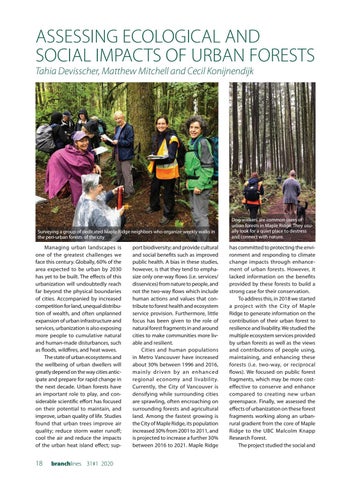ASSESSING ECOLOGICAL AND SOCIAL IMPACTS OF URBAN FORESTS Tahia Devisscher, Matthew Mitchell and Cecil Konijnendijk
Surveying a group of dedicated Maple Ridge neighbors who organize weekly walks in the peri-urban forests of the city
Managing urban landscapes is one of the greatest challenges we face this century. Globally, 60% of the area expected to be urban by 2030 has yet to be built. The effects of this urbanization will undoubtedly reach far beyond the physical boundaries of cities. Accompanied by increased competition for land, unequal distribution of wealth, and often unplanned expansion of urban infrastructure and services, urbanization is also exposing more people to cumulative natural and human-made disturbances, such as floods, wildfires, and heat waves. The state of urban ecosystems and the wellbeing of urban dwellers will greatly depend on the way cities anticipate and prepare for rapid change in the next decade. Urban forests have an important role to play, and considerable scientific effort has focused on their potential to maintain, and improve, urban quality of life. Studies found that urban trees improve air quality; reduce storm water runoff; cool the air and reduce the impacts of the urban heat island effect; sup-
18
branchlines 31#1 2020
port biodiversity; and provide cultural and social benefits such as improved public health. A bias in these studies, however, is that they tend to emphasize only one-way flows (i.e. services/ disservices) from nature to people, and not the two-way flows which include human actions and values that contribute to forest health and ecosystem service provision. Furthermore, little focus has been given to the role of natural forest fragments in and around cities to make communities more livable and resilient. Cities and human populations in Metro Vancouver have increased about 30% between 1996 and 2016, mainly driven by an enhanced regional economy and livability. Currently, the City of Vancouver is densifying while surrounding cities are sprawling, often encroaching on surrounding forests and agricultural land. Among the fastest growing is the City of Maple Ridge, its population increased 30% from 2001 to 2011, and is projected to increase a further 30% between 2016 to 2021. Maple Ridge
Dog-walkers are common users of urban forests in Maple Ridge. They usually look for a quiet place to destress and connect with nature.
has committed to protecting the environment and responding to climate change impacts through enhancement of urban forests. However, it lacked information on the benefits provided by these forests to build a strong case for their conservation. To address this, in 2018 we started a project with the City of Maple Ridge to generate information on the contribution of their urban forest to resilience and livability. We studied the multiple ecosystem services provided by urban forests as well as the views and contributions of people using, maintaining, and enhancing these forests (i.e. two-way, or reciprocal flows). We focused on public forest fragments, which may be more costeffective to conserve and enhance compared to creating new urban greenspace. Finally, we assessed the effects of urbanization on these forest fragments working along an urbanrural gradient from the core of Maple Ridge to the UBC Malcolm Knapp Research Forest. The project studied the social and






